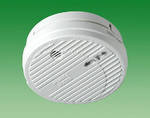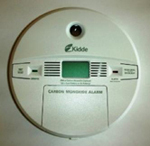Many homeowners believe that their smoke alarms and carbon monoxide alarms last forever. Well, the answer is THEY DO NOT….
All smoke alarms need to be replaced every 10 years. And, depending upon manufacturers, carbon monoxide (CO) alarms need to be replaced every 5-7 years. Even though an alarm may sound when you push the test button or replace the batteries, an out dated alarm does not provide the level of protection you need. Sensors weaken and can become obstructed over time. Check the age of every alarm in your home. If smoke alarms are over 10 years old, or carbon monoxide alarms are over 5-7 years old – they should be replaced immediately!

Smoke alarms, when properly, installed, give an early audible warning needed for safe escape from fire. This is critical, given the majority of all fire deaths occur in the home, and most of these occur at night during sleeping hours.
Smoke alarms should be tested monthly by pushing the test button. Once a year, use a smoldering cotton string, candle or incense until the smoke makes the alarm sound (test from the side of the alarm not directly under – sensors are on the side). If the alarm is battery-powered and doesn’t sound, replace it with a new battery and try again. If it’s electrically connected to household circuits and doesn’t sound, check the fuse and try again. In either case, if the alarm still isn’t working, replace the entire unit.

Known as the silent killer, Carbon Monoxide (CO) is an odourless, colorless gas produced by incomplete burning of fuel, such as propane, kerosene, gasoline, oil, natural gas, wood and charcoal. Sources of CO in homes can include malfunctioning gas-fired appliances, space heaters and chimney flues. Each year, more than 450 people die and about 10,000 seek medical attention for accidental carbon monoxide poisoning. Symptoms of CO poisoning include nausea, fatigue, headaches, dizziness, breathing difficulty and confusion – but they are general enough to be confused with the flu. A CO alarm is designed to sound before symptoms would occur in an average adult. Exposure to carbon monoxide can be deadly. You can’t see it, smell it or taste it. The National Fire Protection Association recommends that, for the best protection, homeowners install one carbon monoxide alarm on every storey in your home.
In addition to installing at least one cUL or ULC listed CO alarm, in your home, these measures may help to prevent CO poisoning:
CO alarms wear out. Be sure to replace them every 5-7 years to upgrade to more advanced CO-sensing technologies and new innovative safety features. Remember too that some CO alarms have batteries in case of power failure in your home – install fresh batteries at least once per year (or when you do your smoke alarms). Consider an alarm with a digital display screen that will show you the CO level in your home. This makes it easier to spot changes in your home’s air quality that could indicate a potential problem.
Don’t cut corners when it comes to fire and CO protection for your family. Maximize your peace of mind by installing the correct number of approved alarms and detectors in your home.
Call Hi-Lite Electric today for replacement of your old smoke alarms, or for installation of new combination “Smoke/CO Alarms”.
If your carbon monoxide alarm goes off, the first step is to silence it. Next, swiftly move everyone to fresh air, preferably outdoors or near an open door or window. Ensure all individuals are safe and accounted for. Immediately dial emergency services, your local fire department, or 911 and inform them that your carbon monoxide alarm has activated. Refrain from re-entering the building or moving away from the open door or window until emergency responders arrive, the area is properly ventilated, and your carbon monoxide alarm returns to its normal state. Safety is paramount when dealing with carbon monoxide alarms.
No, standard carbon monoxide alarms are designed solely for detecting carbon monoxide and won't respond to explosive gases. To identify the presence of explosive gases, you'll require a dedicated explosive gas detector. These detectors are designed to sense various types of explosive gases, such as natural gas or propane. It's advisable for homes using these gases to have at least one explosive gas leak detector for added safety. Carbon monoxide alarms and explosive gas detectors serve different purposes and should be used accordingly to protect against their respective dangers.
Avoid installing carbon monoxide alarms in specific locations. Don't place them in garages, kitchens, or areas prone to dust, dirt, humidity, or grease. Also, steer clear of spots exposed to direct sunlight or extreme temperatures, like unconditioned crawl spaces, unfinished attics, poorly insulated ceilings, and porches. Ensure alarms aren't obstructed by curtains or other objects. Never install them near turbulent air sources such as ceiling fans, heat vents, air conditioners, fresh air returns, or open windows, as moving air could hinder carbon monoxide from reaching the sensors. Proper placement is essential for the effectiveness of carbon monoxide alarms.
The quantity of smoke detectors required hinges on your home's size.
To ensure your safety, it's essential to test your smoke detectors monthly. Simply press the test button on the alarm. For precise guidance, refer to the manufacturer's instructions that accompany your specific detector. Consistent testing helps verify that your smoke alarms are in proper working order, ready to alert you in case of a fire.
Install smoke alarms in key locations for safety. Place one in every bedroom, just outside each sleeping area, and on every level of your home, including the basement and attic. To prevent false alarms, keep smoke detectors at least 20 feet away from appliances like furnaces and stovetops, and maintain a minimum 10-foot distance from humid areas such as bathrooms and laundry rooms. It's vital to note that a significant number of home fire fatalities occur during sleep, making it crucial to have working smoke alarms in and around sleeping spaces for early detection and warning.
© 2023 Licensed Electrical Installation & Service – Hi-Liteelectricinc.ca
All Rights Reserved.